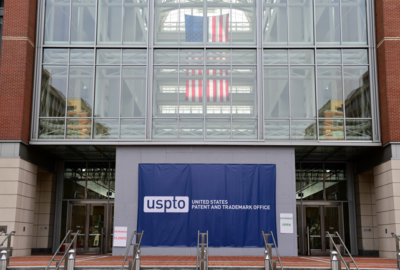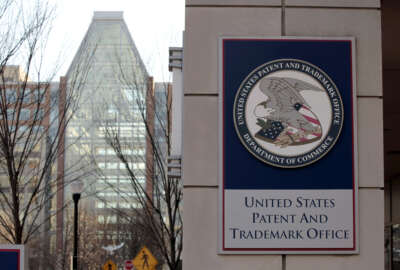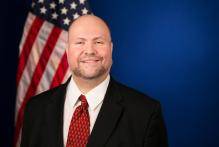USPTO pilots a program to trim patent pendency, and ease things for certain applicants
Best listening experience is on Chrome, Firefox or Safari. Subscribe to Federal Drive’s daily audio interviews on Apple Podcasts or PodcastOne. The U.S. Patent...
Best listening experience is on Chrome, Firefox or Safari. Subscribe to Federal Drive’s daily audio interviews on Apple Podcasts or PodcastOne.
The U.S. Patent and Trademark Office is about to launch a program called the Deferred Subject Matter Eligibility Response Pilot. It lets certain patent applicants hold off on time-consuming answers to questions early in the patent process. For what it’s all about and why it matters, the Federal Drive with Tom Temin turned to the deputy commissioner for patents, Bob Bahr.
Interview transcript:
Tom Temin: Mr. Bahr, good to have you on.
Bob Bahr: Hi, thank you.
Tom Temin: And this is a pretty arcane topic here and very lawyerly. So rather than try to explain it. That’s why we’re having you on to explain it. And just give us a little bit of background on the basic steps of the patent process and what you’re trying to fix here.
Bob Bahr: So basically, when an application is filed at the PTO, we examine it to make sure it’s entitled to meet the statutory conditions for patentability. Primarily, those are whether it is eligible for patenting, it is the type of thing for which we will grant a patent, whether it is new and not obvious over that which is already known, and whether the disclosure of the application was clear and sufficient to allow others to know what was being invented. In this process, most of the work involves determining whether it is new and not obvious over that which is already known, that makes up the most of the work. And the process here is usually iterative, there is some back and forth between an examiner and an applicant, before an application is finally approved for patenting or finally rejected.
Now, as further background, we have engaged in something we call compact prosecution since at least the 1960s. And that is that we examined for all of these patentability requirements in every time we look at the application. And what has happened here is that over the last 15 years, there have been some court decisions that have made that first question, whether something is eligible for patenting, more complicated than it has been in the past. And this has led some to question whether it might make some sense to do the other analysis first. That is, whether it’s novel and not obvious over what is already known and whether the disclosure is sufficiently clear. Before getting into the question of whether or not it’s actually eligible for patenting, or whether it’s the type of thing for which we grant patents. That would save examiners and certainly applicants, the problems of actually having to address that issue, unless it actually comes up and matters. So this pilot tests that premise, namely, we’re going to still have examiners do any eligibility for patenting analysis. But we will let applicants decide whether they want to defer responding to that until they have dealt with all of the other matters that they need to deal with to get a patent, namely, determining whether or not the invention is novel and not obvious over what’s already known.
Tom Temin: And this pilot is launched in response to some inquiries from a couple of senators. So it sounds like maybe the inventor community was unhappy with that particular aspect of that preliminary determination process.
Bob Bahr: Yes, we have received a number of comments from the public that considering applications for patent eligibility or whether or not they’re the types of things for which we grant patents has become more complicated now. And maybe it makes sense to do the analysis on whether it’s novel and non-obvious first. And this obviously has gotten the attention of several senators who did write us a letter suggesting that we see whether or not it makes sense to allow applicants to defer the analysis of whether or not something is eligible for patenting until the other matters are cleaned up. Namely, whether or not something is new and not obvious over that which is already known.
Tom Temin: Right, so you could get an application in for wrapping chewing gum and silver colored paper, and that would touch off this process. Now, is this open to all patent applicants, or it looks like it has to be at the discretion of the examiner?
Bob Bahr: Yes, the way the program works is there’s a few thresholds that have to be met. First, the application would have to raise on these patent eligibility issues. While it is something that is very concerning to stakeholders, this question of whether something is the type of things for which we grant patents, it only comes up in fewer than 10% of applications. So it does not come up as often as people might think. So first, unless an application raises those issues to the examiner, there’s no reason for it to be in this pilot. And second, the application would have to raise issues other than eligibility for patenting because if that’s the only issue then it makes sense to go right to that issue. And next, since this is a pilot, we have allowed examiners to volunteer for the pilot. So we feel that we are getting enough interest from examiners that we will have enough examiners to test this pilot in various technologies. So what the examiner would do would be to in the initial actions that they send to the applicant, they would indicate that this case is eligible for inclusion in the pilot and then it’s voluntary on the part of the applicant, the applicant can say that they want to join in as part of this pilot, or the applicant can just do the normal examination prosecution process where they respond to all the rejections.
Tom Temin: We’re speaking with Bob Bahr, he’s the deputy commissioner for patents at the U.S. Patent and Trademark Office. And how is the pilot being launched, pursuant if it proves successful, to a requested change in statute for patent law?
Bob Bahr: Well, this actually wouldn’t require a change in the patent laws, it would just require a change in our examination processes. Like I mentioned earlier, it has been at least since the 1960s, we’ve engaged in a compact prosecution where we examine for everything all the time. The patent laws do require that we examine applications for patents, but they don’t specify that we have to do everything in every response to the applicant. We simply have done that for many years, since it has historically been the most effective way of doing it. But this pilot will test whether there is a better approach in certain applications, namely, the ones that raised what we call patent eligibility issues, or issues of whether or not something is the type of thing for which you can get a patent.
Tom Temin: And what are your measures for knowing that the pilot is working or that this change is warranted?
Bob Bahr: We have many applications that were, say examined last year, or the years before that have been examined under the classic compact prosecution measure. And we will know which applications are in this pilot, namely those that the examiner has issued an invitation to the applicant to join in the applicant has joined. We will simply measure how long it has taken for the pendency of the applications done the old fashioned way. And the applications done under this pilot. And we can see how many iterations it has taken to get the application to the end of the process. Namely when it has been approved for patenting, whether the applicant has decided not to go any further with the application. And we can simply compare these two groups to see which one is more efficient.
Tom Temin: So pendency, that is how long it takes the whole process. That’s always an issue, you’re looking for ways to trim fair to say?
Bob Bahr: Yes, we look to trim two things. The first is pendency, overall pendency. Currently overall pendency, less than 24 months or less than two years. We also want to see for efficiency, how many back and forth is needed. Obviously the fewer back and forth between the applicant and the examiner, it’s less costly on both the USPTO and for applicants. So we’re looking to minimize both of those.
Tom Temin: And what about the quality of patents? Do you expect that this could help increase that measure also?
Bob Bahr: Well, we have an office of patent quality assurance, and we do random reviews of applications. And we would certainly include these applications in those random reviews. So we can check to make sure that there’s no change in quality, or namely that there is a change, if any change, it’s a positive change in quality, or at least not a negative change in quality. But we will certainly look for that.
Tom Temin: And this pilot runs from Feb. 1, I guess to what, the end of June, correct?
Bob Bahr: Yes, it runs from Feb. 1 until the end of July.
Tom Temin: All right, and how many applicants potentially could come through that would be subject to this in that time? Would you get a good enough database in that amount of time?
Bob Bahr: Well, we feel that we have enough examiners who have expressed interest in the pilot that we should have enough, I’ll say invitations to applicants, and then hopefully we will have enough applicants take us up on it so that we’ll have a good enough number. Obviously, if we don’t have enough numbers to draw any conclusion, we can always extend a pilot or run the pilot again to make sure that we do have enough applications to make a judgement as to whether or not this is a more efficient process.
Tom Temin: And if you decide that this is a good process that you want to keep permanently would that require rulemaking or can you just go ahead and say this is the way it is?
Bob Bahr: I believe that we can go ahead and say that this is the way it is. It should be simply a memo or instructions to examiners to examine it in this manner. We could check but if there is any rule change, it would be a fairly minor one just to our internal operations at the PTO.
Tom Temin: All right, Bob Barr is the deputy commissioner for patents at the U.S. Patent and Trademark Office. Thanks so much.
Bob Bahr: Thank you.
Copyright © 2025 Federal News Network. All rights reserved. This website is not intended for users located within the European Economic Area.
Tom Temin is host of the Federal Drive and has been providing insight on federal technology and management issues for more than 30 years.
Follow @tteminWFED






